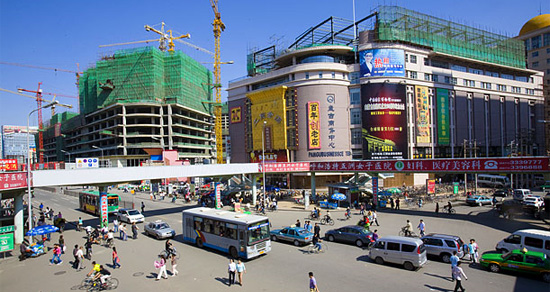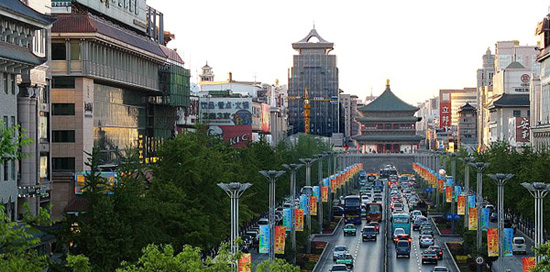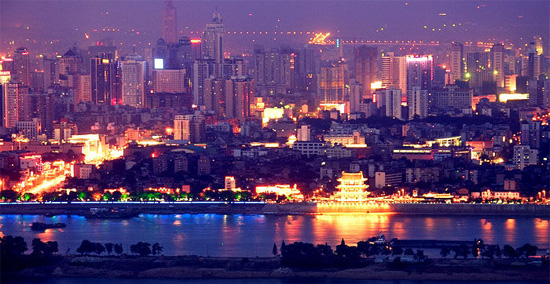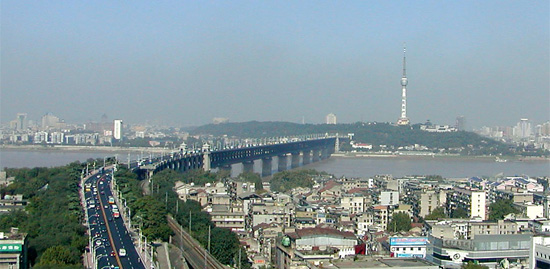China’s Fastest Growing Provinces: The Demographics
Nov. 8 – At the recent Economist China Summit, Michael Koenig and Christophe Bezu, of Bayer and Adidas respectively, emphasized that Central China would experience renewed growth and development as per capita GDP and household disposable income increased at the same time that the coastal areas experienced a slowdown.
Last week, we featured the top five fastest growing cities in China, Hefei, Baotou, Shenyang, Changchun and Hohhot. Today, we look at the five of the emerging provinces: Inner Mongolia, Shaanxi, Hunan, Jilin, Hubei. It is no real surprise that they are all inland.
Inner Mongolia Autonomous Region

Inner Mongolia is blessed with natural resources. It has large coal reserves, iron reserves and forests. Coal and electricity generation is seen as the key industries for the economic development. Presently, Inner Mongolia provides Beijing with a third of its power supply and this rate is likely to increase as more projects are underway to utilize wind generated power. The region’s low quality transportation system has hindered development as well the lack of modern logistics functions like information systems and refrigerated or cold chain facilities. Despite these, the region was able to post robust growth in the past years.
Fast facts
- Inner Mongolia is China’s third largest province with a total area equal to that of France and Spain combined
- The province has the second largest coal reserves in China worth an estimated 223.2 billion tons and some 89 percent of the world’s known 150 types of mineral resources
- Han Chinese compose 80 percent of the population with around 17 percent being Mongols. Other nationalities living in the province include Daur, Evenks, Oroqin, Hui, Manchus and Koreans
- Oil reserves are estimated to be as much as 4 billion tons
- Wind farming for electricity production is a growing energy source
Infrastructure
The region has 83,000 kilometers of highway connecting 95 percent of townships. The ongoing Inner Mongolia Transport and Trade Corridor project will upgrade its highway infrastructure and should improve international trade when it is completed this year.
There is a total of 8,058 kilometers of railway that links the region to the country’s national network and internationally to Russia and Europe. Most major cities in the province can be reached by rail. The region has 18 international-border ports including Manzhouli and Erenhot, the two biggest rail ports in the country.
There are 10 airports in Inner Mongolia. The most important being the Hohhot International Airport and the Baotou Airport which serves the region’s largest industrial city.
Inland river navigation is limited. Only the upper section of the Huang-Ho river, as far as Ho-k’ou is considered navigable. Thus the preferred way of transport in the region is either by road or air.
Economy and Investment climate
The region’s natural resources have fuelled economic development notably in coal, power generation, and forestry related industries. In 2009, GDP was RMB974 billion, an increase of 16.9 percent from the previous year. Its rapid growth rate surpasses most of its provincial neighbors and its economy today is especially impressive given that the province’s GDP was at a mere RMB391 billion in 2005.
Per capita GDP in the region is the highest in central China at RMB25,092 as well as per capita disposable income at RMB12,378. During the same period, utilized foreign investment was US$2.15 billion. Exports reached US$2.95 billion while imports were at US$4.8 billion.
The region plans to double coal output by 2010 to 500 million tons of coal a year. Currently, the region delivers a total of 55.5 billion kilowatts to its neighboring provinces.
Another major industry in the region is milk production. Due to its rich natural grasslands, there are many large milk producing facilities located in the region. In 2007, food company, Nestle, invested on its third dairy factory in the country – the Nestle Hunlunbuir facility at an initial investment of RMB130 million.
The country’s top coal producer, Shenhua Group Corporation, also has plans for a liquefied coal-oil project worth US$6.6 billion. Upon completion, the project will use 3.45 million tons of coal annually to make 1.08 million tons of liquid products including diesel oil, liquefied petroleum gas and naphtha.
Local authorities encourage investment in the industries of energy, chemicals, metallurgy, equipment manufacturing, processing of farm produce, and high-tech products.
Shaanxi Province

Resource-rich Shaanxi Province has seen significant developments in the past few years. Coal supplies are plentiful and of a high quality. This is in addition to the large reserves of natural gas and oil. The province can also boast a rich history and an already prosperous tourism industry is expecting further development both from domestic and international visitors. However, development has been somewhat lopsided; an underdeveloped infrastructure has left many areas in poverty particularly the south of the province.
Fast facts
- Mineral resources in Shaanxi are ranked the highest of all China’s provinces, particularly coal, oil and natural gas
- The province has a strong pool of well educated workers, ranked third in the country
- Not to be confused with neighboring Shanxi Province, the “shan” is pronounced using the third tone
- The “cradle of Chinese civilization,” Shaanxi is also considered an authentic history museum due to the number of historical places of interest and artifacts in the region
Infrastructure
By the end of 2005, Shaanxi’s nine national highways covered a total distance of 1,226 kilometers, however, much needed road development has continued since then. In early 2007, the World Bank approved a US$300 million loan to help finance a project to improve links to the Ankang region of Shaanxi. The project, estimated to be at US$735 million, will improve road access to Shaanxi’s poorest regions.
Shaanxi has 13 major railway lines. The Eurasian Continental Bridge, which links Lianyungang to Rotterdam, passes through the province.
There are five airports in Shaanxi. Xi’an’s Xianyang Airport sees the highest volume of traffic including international connections, and is one of China’s most modern airports. There are also airports at Ankang, Hanzhong, Yan’an, and Yulin.
A flood control and navigation project in Hubei is due to be completed in 2020 and will provide Shaanxi with a key inland, waterway transport route. Once completed, the project will allow 500-ton vessels to navigate in and out of the Ankang reservoir.
Economy and investment climate
Shaanxi’s GDP has been developing robustly in the last few years. Before 2004, its GDP growth rate hovered around 10 percent, and it has been above 12.5 percent since 2004. In 2009, GDP was RMB817 billion with a growth rate of 13.6 percent.
Natural resources are crucial to Shaanxi’s development – the province ranks third in coal production, and fifth in oil production nationwide. A complete industrial system comprising high technology, fruit, animal husbandry, tourism, national defense, energy and chemical industries has been formed. Large reserves of natural resources have been a spur to heavy industry such as oil drills, and equipment for mining, railways, petroleum, and chemical processing. In agriculture, the main produce is fruit and grain. Regulations are also in place to encourage investments in infrastructure, chemicals, pharmaceuticals, metallurgy, machinery, electronics, light industry, and building materials.
Utilized foreign investment in the province was US$1.195 billion in 2007, more than double the amount invested in 2003. Exports grew by 28.7 percent to US$4.67 billion; imports grew by 28.7 percent to US$2.22 billion. The province has a trade surplus of US$2.45 billion in 2007. Shaanxi has more than 2,000 science and technology research institutes, ranking the province behind only Beijing and Shanghai in terms of research and development. It has taken a leading role in research into aviation, aerospace, equipment manufacturing, electronics, and agriculture.
The province aims to reduce the energy consumption by 25 percent during the 11th Five-Year Plan. More than 8,000 illegally-run coal mines and those with an annual capacity of less than 90,000 tons have closed since 2005.
Hunan Province

There is an old Chinese saying that goes, “A good harvest from Hunan and Guangdong can feed the whole country.” Hunan has the advantage of fertile land, warm climate and ample water supply that allows it to have a strong agricultural industry.
Fast facts
- Hunan takes its name from Dongting Lake
- Home province of famous communist leaders, namely Mao Zedong, Liu Shaoqi and Zhu Rongji
- The province produces more than 10 percent of China’s total rice output
- Local cuisine is famed for its use of chilies
Infrastructure
Hunan has a comprehensive transportation network, making it easily accessible by air, river or road. There is the major Yangtze port at Yueyang, and two ports along the Xiang river at Changsha and Zhuzhou. River transportation has also helped economic growth of the province. In addition, Yueyang’s Chenlingji port is scheduled for upgrades to be completed by 2010.
There are seven national highways that pass through Hunan, including the Beijing-Zhuhai highway. This makes all major cities within the province accessible by highway, with Changsha and Zhuzhou being the most convenient. Direct container trucks can also reach Hong Kong from Hunan province within 24 hours. The province’s road infrastructure allows for easy transportation access to both Macau and Hong Kong.
Seven major railway lines run through Hunan; linking the province to all parts of the country and running to a total distance of 2,802 kilometers. By length of highways, Hunan ranks at ninth place in the country. The Wuhan-Guangzhou high-speed line will also pass through Hunan and will be open to traffic in 2010.
Hunan has five airports. The Changsha, and Zhangjiajie airports have direct flights to Hong Kong, South Korea and Bangkok and as well as domestic routes.
Chenglingji, located in Yueyang is the only major Yangtze port in the province. Freight of up to 5,000 tons can be transported from the port via the Yangtze to the country’s coastal and international ports. There is also the Changsha Xianing harbor with a capacity of 8,000 tonnage and the Yueyang foreign trade wharf that can handle 5,000 tonnage.
Economy and investment climate
In 2009, Hunan’s GDP reached RMB1.31 trillion with an annual growth rate of 13.7 percent.
Hunan’s traditional strength has always been agriculture but it has also expanded to key industries like metallurgy, machinery, electronics, chemicals, and textiles. The province is the top producer of rice in the country and ranks at fourth place for tea production.
Contracted FDI for 2007 was US$3.99 billion while used FDI amounted to US$3.27 billion. The province’s export figures were at US$6.52 billion during the same period while imports amounted to US$3.17 billion. Its largest foreign trade partners are the European Union, Japan, and the United States, among its trade relations with more than 170 countries in the world.
In terms of education, Hunan boasts of 93 colleges and universities, as well as 17 national laboratories, six national engineering research institutes, and 22 provincial engineering research centers.
Jilin Province

Jilin province has rich natural resources. Crossed by the Songhua River, Jilin’s well watered and fertile plains yield great agricultural benefits for the region, and the mountainous southwestern areas are an important source of timber. Popular industries include automobile production, petrochemicals and agriculture. Following suit with its prosperous northeastern neighbors, Jilin’s economy continues to thrive.
Fast facts
- Jilin is one of the most important commodity grain bases in China
- The province is ranked sixth in timber production
- Major cities include Changchun, Jilin, Baishan, Baicheng, Siping, Yanji, Songyuan, Tonghua and Liaoyuan
- The yields from ginseng and deer antlers are among the largest in China, being used extensively in traditional medicines
Infrastructure
There are 35,216 kilometers of highways, including over 500 kilometers of expressways.
The province has an excellent rail network, originally built by the Japanese, with Changchun as its main hub. There are four major new railway projects which started construction in 2007. They will include the middle section of a massively invested north-south railway trunk line connecting Harbin and Dalian, and a 96.5 kilometer inter-city railway line from Changchun, capital city of Jilin province, and Jilin city. The four railway projects are estimated to cost RMB13 billion and the province is urging foreign investors to invest in the new project. The Changchun-Jilin line, expected to be completed in 2010, will cut the journey times between the cities from the current 96 minutes to 30.
Major airports include Changchun International Airport, Jilin Airport, Yanji Airport and Tonghua Liuhe Airport.
Jilin is landlocked. However, river navigation is possible from April to November. The major river ports are at Da’an, Jilin city and Fuyu. In 2007, Jilin started construction on a two-phase RMB60 million comprehensive river port; the first phase of this is finished. The port is located on the Songhua River and has an annual throughput of two million tons and will connect to the waterways of Northeast China.
Economy and investment climate
In 2009, the GDP of Jilin province totaled RMB727.75 billion, a year-on-year increase of 13 percent. Its GDP has been rising at double-digit rate since 2003 and has more than doubled since 2005.
The province has a strong background in machinery, petrochemicals, pharmaceuticals, foods, metallurgy and forest industries. At present, automobiles and petrochemicals are its pillar industries. The Changchun First Automobile Manufacturing Warehouse was the first advanced car manufacturer in China. To this day, Changchun remains one of the largest automobile production bases in the country. Jilin is also an important petrochemical production base, represented by the Jilin Oil Field and the Jilin Chemical Industry Corporation. It produces a wide variety of chemicals for use in foodstuffs, medicines, textiles and other light industries.
The provincial government has taken firm steps to make its work more transparent and efficient, as well as to enhance public supervision. An event titled Credit Jilin was held in 2006, calling for businessmen to enhance their credibility. During the event, the province strengthened its efforts to crack down on financial crime. The third China Jilin Northeast Asia Investment and Trade Expo was held in September 2007 in the capital Changchun. The hope is that the Expo will drive the growth of Jilin’s economy forward by stimulating urban construction and the development of the province’s commerce, dining, tourism and communication sectors.
Since the central government’s decision in 2003 to revitalize traditional industrial bases in Northeast China, the province has seen rapid economic development, with substantial investment growth in fixed assets. Fixed asset investment surged to RMB400.32 billion in 2007, while utilized foreign direct investment rose 37.6 percent. Foreign investments were mainly in manufacturing, agricultural processing and property development. In the future, investments will be encouraged in the auto parts, pharmaceuticals, agricultural products, optical and electronics, infrastructure and public utilities industries.
Changchun, Jilin city and Siping are the major cities attracting foreign investment. There are more than 8,000 foreign investment enterprises in the province. Major investors include Pepsi-Cola, Ford, Chrysler, Pilkington, Siemens and Volkswagen. In 2007, Jilin’s total exports amounted to US$3.9 billion, up 28.7 percent. Major exports included corn, garments, poultry, furniture, vehicles, medicines, mainly to Japan, the Republic of Korea, the United States, Hong Kong and North Korea. Imports totaled US$6.4 billion, mainly from Germany, Japan, the United States, Italy and the Republic of Korea. Major imports included auto parts, fertilizers, chrome ores and machinery. Retail sales of consumer goods rose by 19.3 percent to RMB199.92 billion in 2007. Major consumer centers are located in Changchun, Jilin city and Siping.
An official from Huichun city announced in August 2007 that China, Russia, South Korea and Japan will jointly open a sea to land transport channel. This 800 sea-mile channel will start in Huichun, China and end at Niigata, Japan. On completion the route will cut shipping time from five to six days to around one and a half days. Once opened, container transport capacity will increase, with a minimum of 12,000 vessels per year. This figure is expected to double if operations proceed smoothly. Each of the four parties has its own responsibility: China and Japan are responsible for supplying goods, while Russia is responsible for customs clearance on its territory, storage, loading, unloading and the transfer of goods; South Korea is responsible for the coordination and management of all ships and carriers.
Jilin prides itself on its academic infrastructure. There are 45 universities and colleges of various specialties in the province, and a high concentration of scientists, engineers and tertiary students within the broader community.
Hubei Province

As the cost of doing business in the Yangtze River Delta region increases, Hubei is poised to exploit its proximity to its prosperous neighbor. The province serves an important transport link to the mineral-rich and emerging western regions. In recent years, the province has had no choice but to develop its infrastructure system because of its central location and more importantly because of the construction of the ambitious Three Gorges Dam.
Fast facts
- Home of the famous Three Gorges hydro-electric dam; the most ambitious water conservation project it he world
- Hubei is the province with the highest number of lakes in the country
- The martial art tai chi originally came from Hubei
Infrastructure
The construction of the massive Three Gorges Dam has transformed the province in many ways. Upon completion, the dam is the largest water conservation project in the world with an installed capacity of 18.2 gigawatts and costing RMB180 billion.
There are eight inter-province highways and 118 intra-province highways totaling more than 89,000 kilometers. However, because of the province’s geography developing transportation is not without its share of difficulties. For one, its rivers and lakes make it necessary to build 13 bridges that span across the Yangtze; more than any province in China. Another hindrance is that the province is surrounded by mountains, making highway construction more difficult.
The Beijing-Guangzhou Railway, one of the busiest transport lines in the country, runs through eastern Hubei. The line makes the province an important regional hub because it reached the important lines on the national network.
Of the seven airports in the province, Wuhan Tianhe airport is the first-class civil airport and the only one in Hubei with international routes. There are also airports located at Yichang, Sanxia, Xiangfan, and Shashi.
Hubei has a staggering 163 inland river ports. Wuhan port is the second largest inland port in the country. Beyond the capital there are three ports along the Yangtze that can can deliver trade from overseas – namely the Jingzhou, Yichang, and Huangshi Ports. These ports have a capacity for 5,000 ton seagoing ships throughout the year that sail directly to Hong Kong, Japan, and Southeast Asia as well transfer goods in 130 countries.
Economy and investment climate
In 2009, Hubei’s GDP was at RMB1.3 trillion, a growth of 13.5 percent from last year’s figures. In 2005, the province’s GDP was roughly half of what it is today at only RMB660 billion.
The key industries in the provinces are automobile manufacturing, iron and steel, mechanical and electrical equipment, textiles, chemicals, and building materials. It is the the fourth largest car production center in China. Dongfeng Motor Company, which joint ventures with Nissan, Honda, and Peugeot, and Aeolux Automotive Company are both based in Hubei.
The province also has a flourishing agricultural industry and grows a variety of crops. Hubei’s grain production ranks as one of the highest in China.
Foreign investment has been a major driver of Hubei’s development. By the end of 2007 the province had established economic and trade co-operations with over 160 countries and regions in the world, and approved 11,027 joint ventures. The province was able to successfully attract an estimated total contracted FDI of US$3.82 billion and actual utilization of foreign capital of US$3.5 billion. In 2007, Hubei fixed asset investment amounted to RMB453.4 billion while exports reached US$8.17 billion and imports came in at US$6.68 billion.
Auto maker Dongfeng Honda plans to double its annual production capacity in the province from the current 120,000 units to 240,000 units within five years. The company is a joint venture between China’s Dongfeng Motor Corporation and Japan’s Honda Motor Company.
Two global automobile giants, PAS Peugeot Citroen and Nissan in addition to a number of medium vehicle makers have chosen to manufacture out of the Wuhan Economic and Technological Development Zone.
Hubei has over 2,100 scientific research institutions employing 1.2 million research employees, the fifth highest in China.
For information on investments into China’s inland regions, please contact Dezan Shira & Associates. The firm was founded in 1992 and has conducted business in each of China’s provinces. Please contact info@dezshira.com or download the firm’s brochure for details on the nearest regional office.
Related Reading
China’s Fastest Growing Cities: The Demographics
Economist China Summit – The Debates Discussed
China’s Second Tier Cities? The Third and Fourth Are Catching Up
 Business Guide to China’s Emerging Second and Third Tier Cities
Business Guide to China’s Emerging Second and Third Tier Cities
Provides a thorough analysis of 50 of China’s emerging cities, featuring economic data, infrastructure and investment climate reviews, and a directory to development zones, business associations, media and major hotels in all locations. (217 pages, US$25)
 Business Guide to Beijing and Northeast China (Second edition)
Business Guide to Beijing and Northeast China (Second edition)
A detailed overview of Beijing and Northeast China, including the provinces of Hebei, Heilongjiang, Jilin, Liaoning and Shandong. (184 pages, US$25)
 Business Guide to Shanghai and the Yangtze River Delta (Third edition)
Business Guide to Shanghai and the Yangtze River Delta (Third edition)
A detailed overview of Shanghai and the Yangtze River Delta, including the provinces of Anhui, Jiangsu, Shanghai and Zhejiang. (188 pages, US$25)
 Business Guide to South China and the Greater Pearl River Delta (Second edition)
Business Guide to South China and the Greater Pearl River Delta (Second edition)
A detailed overview of South China, including Hong Kong, Macau, and the provinces of Guangdong, Fujian, Guangxi and Hainan. (196 pages, US$25)
 Business Guide to Central China
Business Guide to Central China
A detailed overview of Central China, including the provinces of Hebei, Henan, Hubei, Inner Mongolia, Jiangxi and Shanxi. (120 pages, US$25)
A detailed overview of West China, including the provinces of Gansu, Guizhou, Ningxia, Shaanxi, Sichuan, Tibet, Xinjiang and Yunnan. (172 pages, US$25)
- Previous Article China’s Fastest Growing Cities: The Demographics
- Next Article China Industry: Nov. 9



























